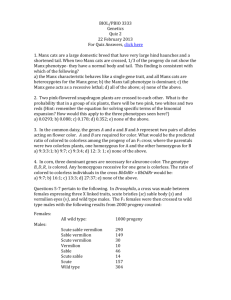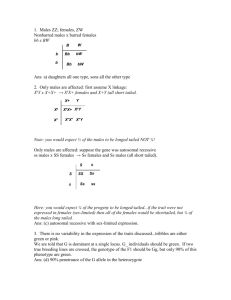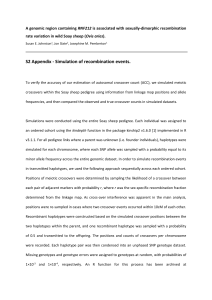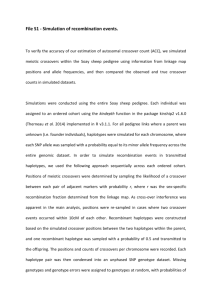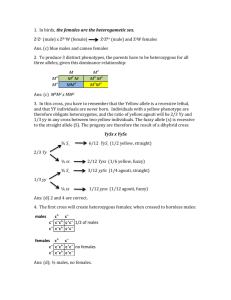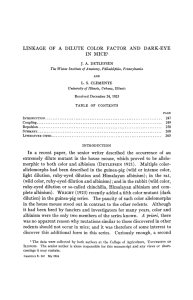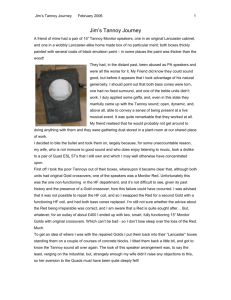moreover locus
advertisement
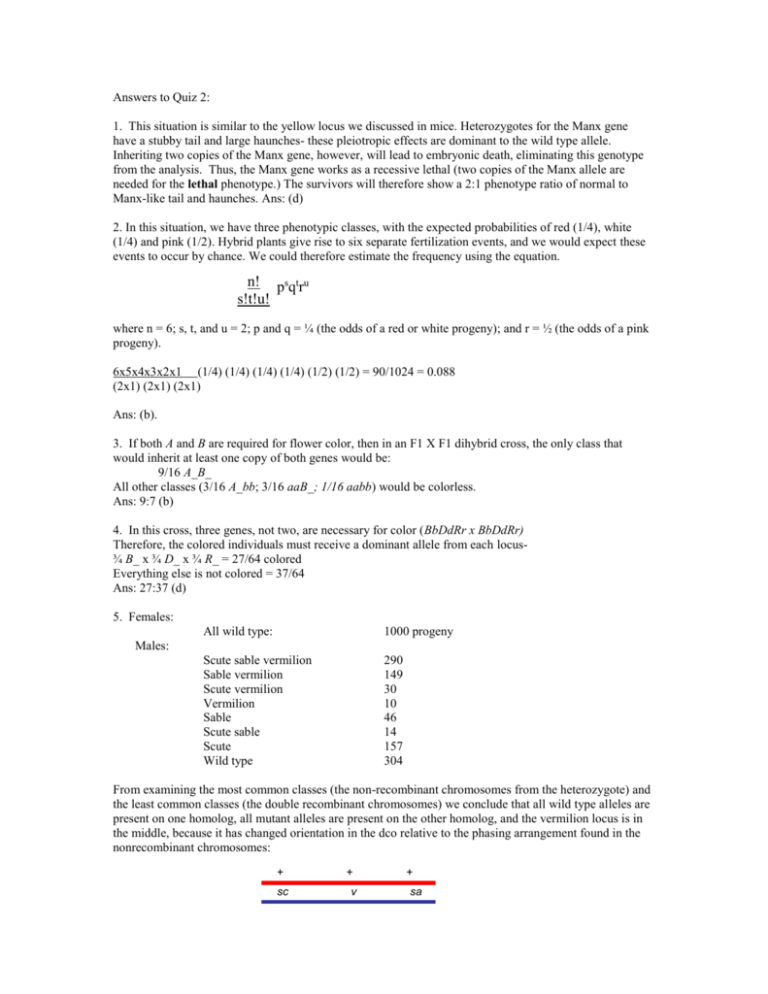
Answers to Quiz 2: 1. This situation is similar to the yellow locus we discussed in mice. Heterozygotes for the Manx gene have a stubby tail and large haunches- these pleiotropic effects are dominant to the wild type allele. Inheriting two copies of the Manx gene, however, will lead to embryonic death, eliminating this genotype from the analysis. Thus, the Manx gene works as a recessive lethal (two copies of the Manx allele are needed for the lethal phenotype.) The survivors will therefore show a 2:1 phenotype ratio of normal to Manx-like tail and haunches. Ans: (d) 2. In this situation, we have three phenotypic classes, with the expected probabilities of red (1/4), white (1/4) and pink (1/2). Hybrid plants give rise to six separate fertilization events, and we would expect these events to occur by chance. We could therefore estimate the frequency using the equation. n! psqtru s!t!u! where n = 6; s, t, and u = 2; p and q = ¼ (the odds of a red or white progeny); and r = ½ (the odds of a pink progeny). 6x5x4x3x2x1 (1/4) (1/4) (1/4) (1/4) (1/2) (1/2) = 90/1024 = 0.088 (2x1) (2x1) (2x1) Ans: (b). 3. If both A and B are required for flower color, then in an F1 X F1 dihybrid cross, the only class that would inherit at least one copy of both genes would be: 9/16 A_B_ All other classes (3/16 A_bb; 3/16 aaB_; 1/16 aabb) would be colorless. Ans: 9:7 (b) 4. In this cross, three genes, not two, are necessary for color (BbDdRr x BbDdRr) Therefore, the colored individuals must receive a dominant allele from each locus¾ B_ x ¾ D_ x ¾ R_ = 27/64 colored Everything else is not colored = 37/64 Ans: 27:37 (d) 5. Females: All wild type: 1000 progeny Scute sable vermilion Sable vermilion Scute vermilion Vermilion Sable Scute sable Scute Wild type 290 149 30 10 46 14 157 304 Males: From examining the most common classes (the non-recombinant chromosomes from the heterozygote) and the least common classes (the double recombinant chromosomes) we conclude that all wild type alleles are present on one homolog, all mutant alleles are present on the other homolog, and the vermilion locus is in the middle, because it has changed orientation in the dco relative to the phasing arrangement found in the nonrecombinant chromosomes: + sc + v + sa sc-v interval: sc 157 v sa 149 v 10 sc sa 14 v-sa interval: sa 46 sc-v 30 v 10 sc sa 14 330/1000 = 0.33 = 33 map units 100/1000 = 0.10 = 10 map units 5. sc-v interval: Ans: (d) 33 m.u. 6. The number of expected double crossovers would be: (0.33) (0.10) (1000) = 33 The number of observed double crossovers was: 14 + 10 = 24 Coefficient of Coincidence = 24/33 = 0.73 Interference = 1 – 0.73 = 0.27 (c) 7. To solve this problem, we essentially need to work backwards. There will be eight phenotypic classes generated from the cross as depicted, a pair of non-recombinant or parental chromosomes, two pairs of single cross-over classes, and a pair of double cross over classes: sc -------------33-------- v ----10--- sa sc + + v + X sa 7. sc + + + v sa nonrecombinant (parental) nonrecombinant (parental) sc v sa + ++ single crossover between sc and v single crossover between sc and v sc + sa +v+ single crossover between v and sa single crossover between v and sa sc v + + + sa double crossover double crossover It is the frequency of the + v + class that we are asked to calculate. From the previous problem, we expect 10% of the meiotic products to show a crossover in the vermilion sable gene interval. The meiotic products representing a crossover in this interval will include both single and double crossover classes. Moreover, from the previous problem, there is evidence of interference, because (0.33)(0.1)(1000) = an expected value of 33 DCOs, but only 24 were detected. This is a coefficient of coincidence of 0.73- only 73% of the expected double crossovers were observed. Let’s first calculate the results expected for the DCO classes. If we were screening 1500 progeny, the number we would expect in this category would be (0.33)(0.1)(0.74)(1500) = 24.4 progeny. Therefore, between 12-13 progeny would be expected in each DCO class. Again, the frequency of crossovers in the v sa interval represents the total number of crossovers, so the number of SCOs would be [1500 (0.1)] – DCO class. This would represent 126 individuals in both classes, or 63 individuals in the + v + class. Note that 63 (sc + sa) + 63 (+ v +) +12 (sc v +) +12 (+ + sa) = 150/1500 = 0.1 Ans: (e) none of the above. Also see problem 11, chapter 12, in Thompson. A<-------------------------10 m.u.--------------->P<--------------------8 m. u. ----------->R a p r Again, the problem needs to be worked backwards. We have no indication of interference, so we will assume an interference value of zero. In this testcross situation, there will be 8 phenotypic classes: Parental nonrecombinants: SCO between P-R: APR apR Apr APr SCO between A-P: aPR Apr DCO: ApR aPr 8. Expected DCOs =( 0.1)(0.08) = 0.008 Total cross overs in A-P = SCOs + DCOs SCOs = 0.1- 0.008 = 0.92 ½ of SCOs in interval would equal aPR frequency = 0.092/2 = 0.046 = 4.6% (b) AB x ab PD>>NPD A and B are linked 9. A to centromere = 22 map units B to centromere = 14 map units A locus B locus PD 1 1 TT 1 2 TT 2 1 PD 2 2 TT NPD NPD 2 2 1 2 2 1 10. True: A and B are on opposite sides of the centromere. The number of second division segregation patterns for BOTH genes is comparable to the NPDs, suggesting that two crossovers are required. 22 + 14 = 36 map units. In addition: A-B: (½ TT + 3 NPD)/total = 42 m.u.
